#contest Telegram Open Network
Explore tagged Tumblr posts
Text
Chapters of an emerging white nationalist network from across the United States participated in a joint combat sports event in the Los Angeles area this August, according to open source evidence geolocated by Bellingcat.
Several Active Clubs, which experts say form a dangerous bedrock for far-right activity and recruitment, joined the second annual tournament alongside extremist groups like Patriot Front and the Hammerskins. Active Clubs are a network of white nationalist mixed martial arts crews inspired by the Rise Above Movement, a now-defunct militant streetfighting group whose neo-Nazi cofounder Robert Rundo is currently in jail awaiting trial on federal rioting charges. They focus on training their members in combat skills in order to prepare them to fight against their purported enemies.
“Their own propaganda says ‘we are a white nationalist sports network, it’s about fitness,’” said Alexander Ritzmann, a political scientist and senior advisor at the Counter Extremism Project who studies Active Clubs, in an interview. “But reading their documents and listening to their podcasts, I’m curious about if they are a combat sports network or if they are a militia hiding in plain sight.”
Participating groups sent fighters to the event, which was organised by white supremacist activewear brand Will2Rise, with winners awarded custom medals.
Promotional content for the contest, which was posted in a Telegram channel affiliated with Rundo’s defunct Rise Above movement, said it took place in Huntington Beach, California, on August 19. Using a video and photos released by a far-right propaganda outlet founded by Rundo, Bellingcat was able to geolocate the event to a gym space in the next city over, Fountain Valley. Both are located in Orange County within the Los Angeles metropolitan area.
(Bellingcat is not naming the outlet, which has promised to release footage from this event and other gatherings to promote white nationalism to a wider audience of young men, to prevent amplification.)
A co-owner of the gym that hosted the event, ION Strength and Conditioning, did not reply to requests for comment. ION has since closed and the space is now run under different ownership with no relation to the event.
11 notes
·
View notes
Text
YAYTSOGRAM: The P2E Game That Lets You Earn Toncoin - How to Play and Maximize Your Rewards

Play-to-Earn (P2E) games have revolutionized the gaming industry, blending entertainment with the opportunity to earn cryptocurrency. YAYTSOGRAM, a memecoin-based P2E game, takes this to the next level by rewarding players with Toncoin ($TON) through its unique gameplay and referral system. Here’s everything you need to know to start earning today.
What is YAYTSOGRAM?
YAYTSOGRAM is an engaging tap-to-earn game built on Telegram's The Open Network (TON). At its core, the game revolves around breaking eggs to earn rewards, with clicks being the primary unit of progress. Every time one of your referrals completes 100 clicks, you get a minimum of 50,000 clicks added to your total, bringing you closer to valuable rewards.
The game's viral nature comes from its powerful referral system and addictive gameplay. With strategic partnerships, ad views, and traffic sales, YAYTSOGRAM generates revenue to ensure steady payouts for its users.
Start playing YAYTSOGRAM now and earn Toncoin!
How to Play YAYTSOGRAM and Earn Toncoin
The gameplay in YAYTSOGRAM centers around breaking different types of eggs, each with its own reward tier. By breaking eggs, players earn Toncoin, with the rewards scaling based on the egg’s level.
Here are the egg levels and their potential rewards:
Starter 20 TON
Silver 30 TON
Gold 40 TON
Platinum 50 TON
Ruby 60 TON
Diamond 70 TON
Adminium 80 TON
Your earnings can increase based on your activity in the game and the engagement of your referrals. The more active your friends are, the higher your chances of earning maximum rewards.
Beyond referrals, players can participate in daily contests, claim bonuses, and complete tasks to boost their rankings. YAYTSOGRAM hosts daily giveaways for the most active users, where top-ranking players receive between 0.1 and 3 TON tokens.
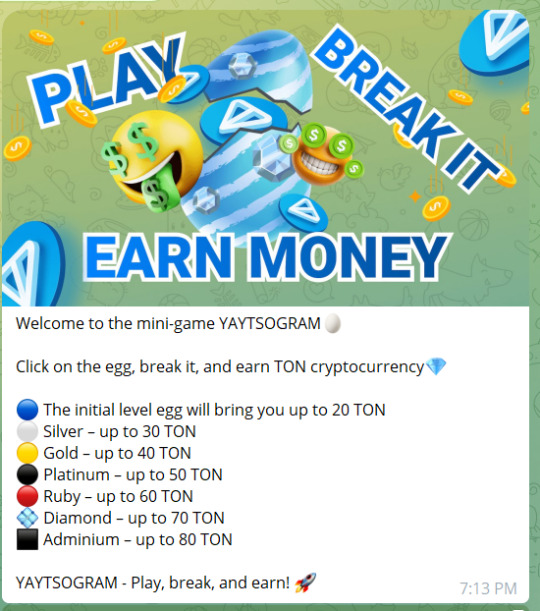
Join YAYTSOGRAM and break eggs to win TON!
How to Break Eggs Faster and Win Bigger Rewards
Want to break eggs faster and earn more? YAYTSOGRAM offers several ways to boost your speed:
In-game Boosters: Special bonuses and auto-clickers can help accelerate your progress. You can earn these by completing tasks or winning contests, helping you rack up clicks faster and break more eggs.
Referral Program: By inviting friends, you can significantly increase your click count. The first 100 clicks from each referral will net you 50,000 clicks, making it one of the most effective ways to progress quickly.
Pro tip: Combine in-game boosters and the referral system to maximize your gains and speed up your earnings.
Boost your gameplay with referrals and start earning more!
YAYTSOGRAM Tokenomics: A Look Into the Future
YAYTSOGRAM’s tokenomics lay the foundation for its long-term growth and sustainability. With a mission to onboard 10 million+ active players, the team plans to launch the in-game YAYTSOGRAM token, offering even more incentives to active users.
Once the game hits 30 million users, YAYTSOGRAM will begin trading its tokens, transitioning from a simple click game into a full-fledged crypto gaming platform. This next phase will open up a broader array of opportunities for players to trade and benefit from the platform.
Additionally, during this phase, YAYTSOGRAM will reward players with free tokens via airdrops, with the number of tokens based on each player’s accumulated clicks. Every action you take in the game brings you closer to more rewards and long-term value.
Don’t miss out on future rewards—join YAYTSOGRAM today!
Final Thoughts
YAYTSOGRAM is quickly becoming a standout in the Play-to-Earn space, with its innovative gameplay, referral system, and consistent rewards. By participating in contests, completing tasks, and leveraging the referral program, you can maximize your Toncoin earnings. As YAYTSOGRAM evolves into a comprehensive crypto gaming ecosystem, now’s the perfect time to jump in and start playing.
Start playing YAYTSOGRAM now and earn crypto while having fun!
Disclaimer: This article is for informational purposes only and should not be considered legal, tax, investment, or financial advice.
0 notes
Text
String Games: Earn Airdrops and more by playing telegram mini-games
You can earn points with the String Metaverse game bot and String Games on Telegram Access the power of cryptocurrency with the help of the String Metaverse Game Bot on Telegram. In this regard, you can smoothly earn TON (The Open Network) tokens plus exclusive airdrops through various fun activities that make it easier to go for crypto reward earning. Here, you can accomplish several tasks while in groups, and keep updated with new cool promotions-all to help you maximize earnings without much hassle.
With the bot, you'll be connected to String Games, a creative community of innovators in gaming. Beyond interacting with fellow gamers, there are contests and promotions that keep the engagement lively. It is where fun and rewards align. The String Metaverse Game Bot is very user-friendly, so access to it is available to both crypto enthusiasts and newbies. Whether newbie or a crypto expert, with updates on airdrops as well as new earning possibilities, you won't miss a single opportunity for building assets digitally. In addition, participation in the community of String Games enhances your gaming experience, offering you new challenges and opportunities for earning rewards. Don't miss out on this great chance. It's an opportunity to elevate your journey into cryptocurrency and gaming adventures. Start earning today by visiting String Metaverse Game Bot, and discover everything that awaits you with String Games. Unlock all the powers of the gaming and cryptocurrency rewards.

Join Now! - https://t.me/string_gamesbot
0 notes
Text
Europe limits the dominance of six tech giants
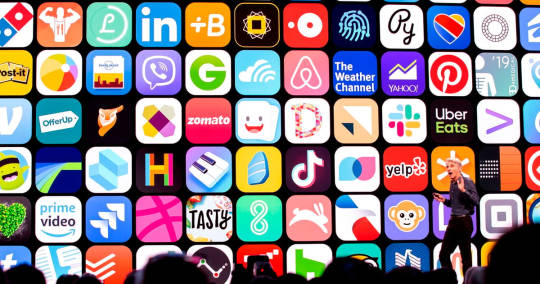
Google, Amazon, Meta, Tiktok, Apple and Microsoft: these are the six companies that Europe designates as 'gatekeeper' and that must adhere to new, stricter competition rules.
The European Commission on Wednesday 6-09-2023 designated six companies as 'gatekeepers'[1]. That list contains no surprises: it concerns Alphabet (Google), Amazon, Meta (Facebook, Instagram), Bytedance (Tiktok), Apple and Microsoft. Those companies have six months, until March 6, 2024, to comply with the rules of the Digital Markets Act, or DMA[2] in short. This means, among other things, that they are no longer allowed to use their dominant position in a certain domain (for example search engines or operating systems) to favour their own products over those of competitors.
This should lead to more competition on the European digital market and, the founders of the DMA hope, to more choice and in some cases lower prices for European consumers. “DMA means more choice for consumers, fewer obstacles for smaller competitors, opening the gates of the internet,” European Commissioner Thierry Breton posted on X, formerly Twitter, on Wednesday.
DMA and DSA
Between now and early next year, the key provisions of two major pieces of European legislation will come into force, together described as a new 'constitution for the internet'. The Digital Services Act[3] (DSA) is about the security and moderation of social networks and online stores, the Digital Markets Act (DMA) is about allowing competition.
In April this year, the European Commission also drew up a list of Very Large Online Platforms or VLOPs[4], the companies to which the strictest provisions of the DSA apply. The lists of the VLOPs (DSA) and the gatekeepers (DMA) overlap. The conditions for being on those lists are also similar: in both cases it concerns services with at least 45 million users in Europe, but the DMA also takes turnover into account.
A number of VLOPs have not been designated as gatekeepers: Twitter, Alibaba, Booking.com, Pinterest, Wikipedia and Zalando.
No Europeans
Also striking: the Korean electronics giant Samsung, previously mentioned as a potential gatekeeper, is ultimately not on the list. This means that it concerns five American companies and one Chinese (Bytedance, the company behind Tiktok, ed.). And, significantly: not a single European company, which exposes Europe to criticism that the DMA has protectionist aims with strict rules that only hinder large foreign players.
There was not much doubt about the names of the six gatekeepers, but it remained to be seen which of their products or services (the so-called core platform services) that designation would apply to. There are a few surprises there.
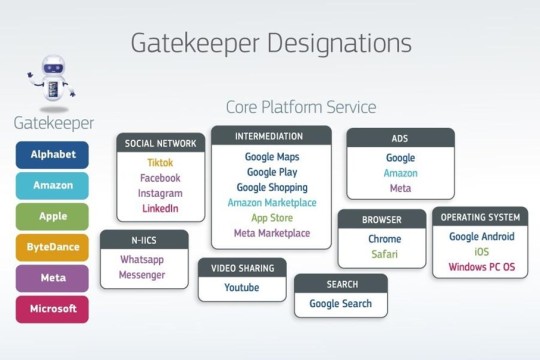
Alphabet (Google) is considered the gatekeeper for seven different services: Google Search, the Google advertising platform, the Android operating system, YouTube, Google Maps, the Google Play app store and the shopping site Google Shopping. Gmail ultimately did not make that list. Meta is on the list with five services.
Procedures are still ongoing for a number of services to determine whether they will fall under the DMA rules, because the companies are contesting the designation. This includes Microsoft's Bing search engine and Apple's iMessage messaging service.
Messaging
One of the most striking – and most controversial – provisions in the DMA is that providers of messaging apps (Whatsapp and Messenger, because iMessage is not on the list for the time being) must allow interoperability. In concrete terms: if the provider of a messaging app such as Signal or Telegram requests this, Meta will be obliged to allow messages to be sent from Signal or Telegram to users of WhatsApp and Messenger, and vice versa.
Initially, that interoperability will be limited: you will be able to forward text messages to an individual person in another chat app. Video calls and group chats will only follow a few years later. The criticism of this obligation is that it reduces the security of messages: apps such as WhatsApp now encrypt all messages in a secure manner (end to end, in the jargon), which becomes more difficult if other apps can connect.
Another visible change would come for iPhone users: Apple should allow users to replace any of its own apps with competing apps, and they should also be able to get those apps from outside Apple's own App Store. Apple said on Wednesday that the company is "concerned" about how the DMA could threaten the security and privacy of European consumers. Apple says it is committed to mitigating those risks.
Source
Dominique Deckmyn, Europa legt dominantie van zes techreuzen aan banden , in: De Standaard, 6-09-20323; https://www.standaard.be/cnt/dmf20230906_94101351
[1] Some large online platforms act as "gatekeepers" in digital markets. The Digital Markets Act aims to ensure that these platforms behave in a fair way online. Together with the Digital Services Act, the Digital Markets Act is one of the centrepieces of the European digital strategy. https://commission.europa.eu/strategy-and-policy/priorities-2019-2024/europe-fit-digital-age/digital-markets-act-ensuring-fair-and-open-digital-markets_en
[2] The Digital Markets Act (DMA) establishes a set of clearly defined objective criteria to identify “gatekeepers”. Gatekeepers are large digital platforms providing so called core platform services, such as for example online search engines, app stores, messenger services. Gatekeepers will have to comply with the do’s (i.e. obligations) and don’ts (i.e. prohibitions) listed in the DMA. https://digital-markets-act.ec.europa.eu/index_en
[3] The rules specified in the DSA primarily concern online intermediaries and platforms. For example, online marketplaces, social networks, content-sharing platforms, app stores, and online travel and accommodation platforms. The Digital Markets Act includes rules that govern gatekeeper online platforms. Gatekeeper platforms are digital platforms with a systemic role in the internal market that function as bottlenecks between businesses and consumers for important digital services. Some of these services are also covered in the Digital Services Act, but for different reasons and with different types of provisions. https://digital-strategy.ec.europa.eu/en/policies/digital-services-act-package
[4] The strictest rules only apply to the biggest players, the Very Large Online Platforms (VLOPs) and Very Large Online Search Engines (VLOSEs), with more than 45 million users in the EU. There was never any doubt that Google, Meta and Amazon would be among them. Google even appears five times on the list: with Google Maps, Google Play, Google Search, Google Shopping and YouTube. But the Commission also mentioned: Meta (Facebook and Instagram), Microsoft (LinkedIn and Bing), Apple, Amazon, Pinterest, Snap, Tiktok, Twitter, Wikipedia, Zalando, Booking.com and AliExpress. More names will be added in the coming weeks. https://www.standaard.be/cnt/dmf20230425_96504173
0 notes
Text

✅ Whitelist private sale community pool Arcade network on Synapse 🟢 WHITELIST FORM 🖍 LINK 🖍 Pool details 🔸️Winners 30 🔸️Slots 30 🔸️Slot value 500 $ Private Sale Schedule: 🔹️24.09.2021 at 9 am UTC The Arcade Network Gleam will start and will be open for an entire week. 🔹️01.10.2021 at 9 am UTC The registration process and the Gleam contest will end, and we will announce the Gleam winners and the ticket size. 🔹️03.10.2021 at 9 am UTC The presale for Arcade Network will start, and you will have a window of 48 hours to participate. 🔹️05.10.2021 at 9 am UTC The Arcade Network presale will end. 🔹️06.10.2021 at 9 am UTC We will return the overallocation for the Arcade Network presale. Arcade Network is the first decentralized gaming marketplace in the world, and they promote quality, variety and freedom in a niche of the market that has always been very reclusive and elitist. Thank you for your participation! --- Crypto IDO 😎 More news in our telegram channel
2 notes
·
View notes
Text
Lovely Inu Finance ($LOVELY)
Lovely Inu Finance ($LOVELY), The Rise of Meme Token Revolution.

#LOVELYINUCOMMUNITY
WEBSITE | WHITEPAPER | TWITTER | facebook | TELEGRAM |
#lovelyinufinance #lovelyinu #lovelytoken #lovelycrypto #lovelywaythemoon #lovelyfinance #lovelybep20 #lovelyxbinance #lovelymemetoken
What is Lovely Finance

Lovely Finance is a new DeFi Protocol that creates a Decentralized financial Ecosystem that designs an open access system utilizing Blockchain technology where it creates a decentralized form of currency which enables an advanced intelligent infrastructure built around a Decentralized as well as Community based Digital economy through Blockchain Technology used on a transparent and distributed public network. Lovely Finance DeFi Protocol Offers a unique and innovative new DeFi concept in the digital economy sector that enables complex financial processes similar to traditional financial markets through highly efficient decentralized technology and In addition Lovely Finance Protocol offers full implementation and Community Based DeFi concept with ecosystem DeFi is managed by its own community where each contributor has the right to choose the development of the platform through the Governance System which will be implemented on their DeFi protocol.
The Lovely Finance team designed the DeFi Protocol which provides a unique platform enabling multiple different revenue streams with High Multiplier Yield Farming Concepts, especially for tangible assets owned by its users. Through Blockchain Technology, Lovely Finance tries to turn a centralized system into a fully Decentralized with access for everyone by Creating a transparent and distributed future financial system through their DeFi protocol. Lovely Finance's Financial Ecosystem offers unique features such as Pool enabling High APY multiplier at low native currency fees and instant Swap feature via DEX which enables instant swap process at real time rates. Lovely Finance Team also created an innovative new DeFi system that is built on the Binance Smart Chain Network so that the costs and time required are very low and become one of the bridges for traditional investor systems to enter the crypto market. For more details About Lovely Finance , you guys can read more details about their System on their official website here; https://lovely.finance/
What is Lovely Token?
Lovely Token is the original currency in the form of Tokenization on the Public Blockchain network that will be used in the Lovely Finance DeFi Protocol as the main transaction tool especially for paying for various services, swaps, staking or forms that are markers for the public to get voting rights. Lovely Token is based on Blockchain Technology which is transparent and distributed via BSC (Binance Smart Chain) thereby facilitating various transaction processes through advanced Smart Contract Automation and Creating a new digital economy trend that is more efficient and innovative. Lovely Finance's DeFi Protocol also implements a system that gives rewards to its holders, namely that every top 10 Buyers will be rewarded with 30% of the total they buy in 1 day, They will also integrate NFT which will use this token as the main transaction tool. Lovely Finance maintains liquidity with a diversified pool and initial liquidity backed by a community built development fund and this ensures a fully community run DeFi Ecosystem.
Values
Transparency
We maintain open comunication with our holders so they can stay current and informed with every step of Lovely's growth.
Community
Ultimately, Lovely is owned by the community, meaning we encourage group efforts related to marketing, community management and more.
Trust
In the cryptocurrency market,Trust paramount.That means not only providing transparency, but also security related to holder funds. Examples include audits of Lovely's code, and liquidity tokens being burnt to eliminate risk of maliclous behavior.
Longevity
Lovely is in it for the long haul. Our plans are for long-term development of the ecosystem which result in a fruitful investment beyond any temporary trends.
Ecosystem
1. Lovely Swap
Launcing on 2021, Lovely swap is a decentralized exchange ( DEX ) where users can swap onyl BEP20 Lovely token for BUSD & BNB.
The largest and safest DEX in the world and acts as the foundation on which Lovely will develop functionality for Lovely holders.
Lovely Stake
Coming in 2021,Lovelt stake is the official NFT/DeFi marketplace where holders can lock ( deposit ) their $Lovely tokens in order to earn exclusive NFTs featured by artists that are part of the Lovely community. Lovely will hold regular contests for artists to show case their work and have the community vote on which should be added to the marketplace. Portions of the fees generated by the NFTs are distributed to the artists, while the rest funds Lovely development.
Lovely Staking

Funding
Use of raised funds
Funds contributed by our community will go towards three things:
1. Marketing
Hiring social media influencers, digital advertising, real-world promotions.
2. Exchange Listings
Increasing our reach by listing on new exchanges to reach new audiences.
3. Product Development
Executing our roadmap and expanding the Lovely ecosystem.
Get $LOVELY Token
Take part in our quest to the moon by contributing your BNB in the presale
The Rise of Meme Token Revolution
Our goal is to make record of grow token price from 0.0000001$ to 1$ in year 2021
Lovely Inu ($LOVELY) is a community-focused, decentralized cryptocurrency with rewards for holders. http://lovely.finance
Lovely Token Info:
Total supply : 100 Quadrillion
Token For sale : 40 Quadrillion
Token Price : 0.00000001$
Fre sale : 10 Quadrillion
Founders : 20 Quadrillion
Bussiness devlolpment : 20 Quadrillion
Team : 10 Quadrillion
Ticker symbol : LOVELY
Token type : BEP20
Distribution of tokens
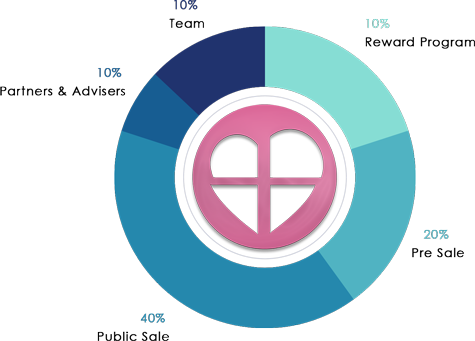
Roadmap
The use of cryptocurrencies has become more widespread, The origin platform idea. Development of the concept and business plan.
Website launch
Nebula Audit
Bounty Campaign + ICO Start
Reward Programm for ICO Participation
ICO Listing on Coincodex
ICO Liquidity Lock For 11 Months
Listing on Pancakeswap
Listing on Congecko
Listing on CoinMarketCap
Start $LOVELY Staking
Launch Lovely Crypto Wallet
Listing on LAToken
Start Lovely Farming & Swap
Listing on 5-6 Best Exchange with Market Push
Listing on Binance
Launch Lovely Crypto Exchange
Founding Team
LOVELY was founded by a 2-Person team that has since expanded into 15+ Community managers with expertise in marketing and product development. Feel free to say “Hi!” on Telegram.

Lovely INU
Founder | Head of Operation

Hideous
Director | Lead Developer
Conclusion
Blockchain technology is one of the new innovations in the global market that introduces a new, more innovative system and one part of Blockchain Innovation is DeFi or Decentralized Finance where this is one of the innovations in the Global market through Blockchain technology which introduces a new financial system with a market size that large and has increased 2x compared to 2 years Previously, DeFi Users also continue to grow and Even so the DeFi Market which lacks innovation and profit-oriented makes its development stalled and therefore Lovely Finance offers all its users a new DeFi system with advanced Smart Contracts and reward system which maintains the value of the ecosystem through a unique protocol that provides maximum transparency and is run entirely by the Community. Lovely Finance also offers secure tokens with NFT implementation which will be implemented in the future. This is a good project and I really recommend you guys to be a part of this great protocol!
JOIN ICO

Get 30% More of Your Purchase Amount
Screenshot of Successful Transaction
TXN ID
Share These Poster to 1 Crypto Groups Excluding 5000 Members
Share a Screenshot of All These Points with Our Telegram Group
30% Extra $LOVELY
Coincodex: https://coincodex.com/ido/lovely-inu/
BSCscan Verified Contract: https://bscscan.com/address/0x9e24415d1e549ebc626a13a482bb117a2b43e9cf
Audit Report: http://lovely.finance/assets/images/audit-report-lovely-inu.pdf
Whitepaper: http://lovely.finance/assets/images/whitepaper.pdf
Airdrop Bot: https://lovelyinufinance.page.link/AIRDROP
Pre-sale will Close up Anytime once it hits the 50 BNB

How to buy?
You can buy now directly from trust wallet
1) goto dapps
2) open website (Select Smart Chain)
3) enter your purchase amount
4) click on buy or purchase button
Presale link : https://lovely.finance/
Contract address :0x9E24415d1e549EBc626a13a482Bb117a2B43e9CF
Useful links to the project
Website: https://lovely.finance/
Twitter: https://twitter.com/Lovely_finance
Telegram: http://t.me/lovelyinu
Instagram: https://instagram.com/lovely_inu
Youtube: https://youtube.com/channel/UC8zILmP8leSpFqOnUdFIpUQ
Whitepaper: https://lovely.finance/assets/images/whitepaper.pdf
AUTHOR
Bitcointalk Username: Manuel Akanji
Bitcointalk Profile: https://bitcointalk.org/index.php?action=profile;u=2954998
BEP-20 Address: 0x00F321558065b1c9dca5e6EcbeECE9B01F73D6E1
1 note
·
View note
Text
TON è stato confermato da Telegram!
#TON è stato confermato da Telegram!
È passato un pochino di tempo dall’ultima volta che abbiamo parlato di Telegram Open Network (TON) all’interno del nostro blog. Quindi quale miglior modo di ritornare a parlare di questo progetto marchiato Telegram, se non a poche ore distanza dal lancio del contest dedicato proprio a Telegram Open Network (TON). Certo, in realtà noi di InsideTelegram non abbiamo mai smesso di parlare di questo…
View On WordPress
0 notes
Text
MEXC Exchange Will List Nexus Dubai (NXD) - Deposit and Trade to Share 15,000 USDT!
MEXC will list Nexus Dubai (NXD) in the Innovation Zone and open trading for the NXD/USDT trading pair. The specific timeline is shown below:
Deposit & withdrawal: Opened
NXD/USDT Trading: 2022-02-25 06:00 (UTC)
* Note: The price may move greatly for projects in the Innovation Zone, please be cautious of the risks.

Project Info
(This information is provided by the project team. Strictly for references only.)
Project Name: Nexus Dubai (NXD)
Max Supply: 50,000,000,000
Official Website: https://nexuscoin-dubai.com
Block Explorer (ERC-20): https://polygonscan.com/token/0x228b5c21ac00155cf62c57bcc704c0da8187950b
Telegram: https://t.me/+fpQy3wAJA1VmYjU1
Twitter: https://twitter.com/nexus_dubai
Whitepaper
Project Brief Introduction:
The Nexus Project, in partnership with various companies in the UAE, can be used in many retail stores, restaurants, etc., mainly in Dubai and Abu Dhabi. Stores can also become members without having to spend a large amount of money to install the system as is usually the case
Nexus Token is a bridging multi-network token that supports various networks.
NXD Deposit & Trading Contest - 15,000 USDT to be Won!
In order to thank NXD community members for their support, the NXD team decided to launch a Deposit & Trading Contest with 15,000 USDT to be won! The details are as follows:
1) Deposit and win a share of 7,500 USDT Giveaway
Event Period: 2022-02-24 06:00 - 2022-02-28 15:00 (UTC)
Rules: During the event duration, users that deposit NXD with a minimum net deposit of 10 NXD can share a 7,500 USDT prize pool. Prizes received by each user are proportional to the size of the individual deposit amounts during the event.
2) Trading Contest to win 7,500 USDT Prize Pool
Event Period: 2022-02-25 06:00 - 2022-02-28 15:00 (UTC)
1) Grand Prize
Rules: During the event duration, users who achieve a minimum trading volume of 5,000 USDT can stand a chance to share 5,000 USDT. Users will be ranked according to their total trading volume, rewards distribution are as below:

2) Participation Prize
Rules: All NXD traders with a minimum trading volume of 300 USDT are eligible to share a 2,500 USDT prize pool. Prizes received by each user are proportional to the individual trading volume during the event.
Terms & Conditions:
Net Deposit = Deposit - Withdrawal; Valid Trading Volume = Buys + Sells.
Users participating in this event must complete the required KYC verification before the end of the event to be deemed eligible for the rewards.
Winner list and rewards will be announced and distributed within 7 working days after the event concludes.
Users that ranked in the top 10 traders on NXD Trading Contest are not qualified for the Participation Prize.
MEXC reserves the right to disqualify users that are deemed to be wash trading, illegally bulk registered accounts, as well as trades that display attributes of self-dealing or market manipulation.
This event was initiated by the NXD official team, and the rewards are provided by the project party. All participating users are deemed to participate voluntarily. This event does not constitute any investment advice.
MEXC has the final interpretation right of this event.
Risk Warning
Cryptocurrency investment is subject to high market risk. please make your investments cautiously. MEXC Global will make the best efforts to choose high-quality tokens, but will not be responsible for your investment losses. As a digital asset trading platform that respects the community, MEXC adheres to the principle of truthful, transparent and fair trading, with no malicious intent. We are committed to providing users with a service that is safer, more efficient, and more reliable for the trading of digital assets.
0 notes
Text
OBORTECH
A FULLY DIGITAL ECOSYSTEM FOR YOUR SUPPLY CHAIN

About
Supply-chain industry has multiple actors having varying technical capacities. Yet most of them don’t have stable technical capacity to develop and maintain their communication and data in efficient way. Due to a lack of skilled IT experts, outdated technology, and inefficient business models the overall sector is struggling with complicated and costly logistics procedures. Creation of a simple and efficient communication and data hub built on trusted platform that everyone can use regardless of their technical capacity and knowledge will solve complications and bring significant cost benefits to the sector.
MULTI-WINNER ECOSYSTEM
Better risk analysis and faster trade finance process
Increased operational efficiency and better fleet management
Reduced disputes caused by inconsistent and late data sharing
Transparency on product traceability and provenance
Broader market access and stronger customer relationship
Increased visibility and accurate planning
OBORTECH's Smart Hub VS Traditional systems

THE SMART HUB OFFERS
Blockchain and cloud powered communication hub
Accessible via easy to use web and mobile user interfaces, and an open API, the Smart Hub brings together supply chain actors, and enable their supply chains to share information, collaborate, conduct data analysis, and validate product traceability in real-time on a trusted platform.
Tamper-proof, unified and online document exchange
The Smart Hub allows secure sharing and exchange of documents with supply chain partners using blockchain powered version control. Authorized parties to any shipment can immediately see when changes have been made, and by whom, along a shipment journey.
IoT based real-time visibility and tracking
IoT sensors are installed on containers/trucks and transmit data to the Smart Hub dashboard to track valuable shipments, monitor their key physical measurements, and protect high-value products against theft. A client gets positioning data for shipment in real-time, irrespective of the shipping carrier they choose.
Open and decentralized networking marketplace
Based on the blockchain based trusted network established among the Smart Hub participants, the marketplace ecosystem will enable verification and scoring of stakeholders in supply chain without the need for third-party credentials. Moreover, the marketplace is a blockchain based decentralized ecosystem that enables buying, selling and exchanging of services without the need of intermediaries among the users.
DECENTRALIZED GOVERNANCE
The Smart Hub members themselves are the governing bodies of the network. Before joining, every new member in any supply chain network of the Smart Hub needs to be invited and approved by existing members of that supply chain network in the Smart Hub.
Smart Hub Marketplace open ecosystem
public blockchain
Smart Hub private ecosystem
permissioned blockchain
Smart Hub private ecosystem
permissioned blockchain
Smart Hub private ecosystem
permissioned blockchain
With OBOT tokens, the Smart Hub users can enjoy rewards like express delivery and extra care of products during shipments via the Smart Hub network. Get your OBOT tokens today by participating in our IEO
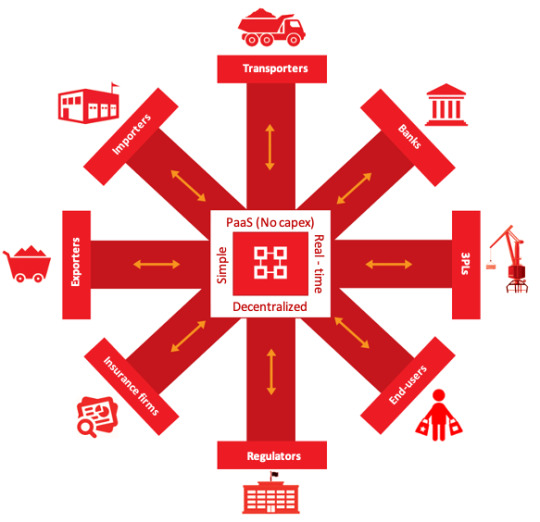
The manual and paper based processes often used in Supply Chain Industries are time consuming and also result in a lot of extra maintenance costs.
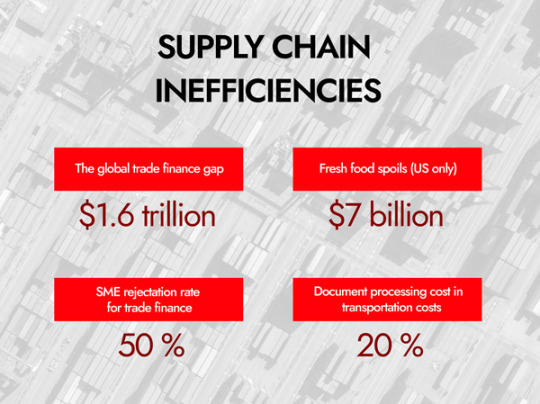
IEO starts on Probit from 10th March 2021
Starting price: ETH 0.000015
Invest upto 1 ETH, get 50% more bonus OBOT tokens
Invest between 1ETH - 2 ETH, get 100% more bonus OBOT token
Invest more than 2 ETH, get 200% more bonus OBOT tokens
TEAM
Tamir Baasanjav: CEO and Founder
He is specialized in project management and strategic communication. He had worked in managerial and expert positions of prestigious international development, government and business organizations such as an agency funded by Government of the United States for transportation and energy efficiency fields, Knowledge Hub project of Swiss Agency for Development and Cooperation on sustainable mining, and the biggest corporate bank of Mongolia. He also has 10 years of experience in UX and product designs. He won the global product design contest held by Adidas.
He designed the Smart Hub concept and its business strategy. He manages the project and leads the product design and marketing/communication.
Enkhbat Dorjsuren: Logistics Lead and Co-founder
He has 20 years of experience in logistics and transportation sector. He is a CEO of Mongolian Express LLC, one of the largest inland transport and logistic companies in Mongolia. He has extensive network in Mongolian transportation and logistics sector.
He established the project’s partnerships in the transportation sector and leads partnership development in Mongolia and Euro-Asia
Tungalag Sukhbat: CFO
She is a finance and investment professional more than 20 years of experience. She has worked in different domains including strategic and financial consulting, central banking, corporate banking, asset management, and multilateral development programs in managerial and expert positions. She achieved CFA Charter in the UK and is a member of the CFA Institute. Moreover, she is a Certified Business Appraiser of Mongolia.
She developed the business plan as well as financial modelling and analysis of the project. She leads financial management and analysis of the project.
Zoljargal Dashnyam: Chief Counsel
She has extensive experience in corporate law and private equity. Her portfolio of clients includes investment banks, multinationals, mining companies, and investment funds. She graduated Harvard Law School in Master of Laws. She was ranked as a top-tier lawyer in Mongolia for 9 years. She is a Senior Partner of the leading law firm in Mongolia, DB>S.
She is in charge of the governance model development of the Smart Hub and legal activities of the project.
Alok Gupta: Blockchain Architect
He is a certified blockchain developer with over 12 years of experience in application development and deep knowledge of Hyperledger Fabric architecture and functionalities. He was in top 5% of Blockchain Architecture Design course conducted by IBM and IIT, a top technology institute in India. He developed various blockchain projects and applications in supply chain, real estate registry, health insurance, etc.
He developed the blockchain architecture and application of the prototype system. He leads the blockchain (Hyperledger) architecture and application development of the project.
Maxim Prishchepo: Blockchain Architect
He is a blockchain architect with more than 6 years of experience in blockchain development and 20 years of experience in architecture designs of complex financial IT systems. He is a qualified analyst in crypto banking & finance. He worked as a core blockchain developer and architect for Energi, 0chain, and Wagerr projects. His main areas of specialization are Bitcoin, Ethereum, PIVX, ZCash and other open-source based blockchain solutions.
He developed the Ethereum smart contract of the project. He leads the token payment system and Ethereum blockchain development of the project.
Mauro Andriotto: Adviser
He is internationally recognized as one of the leaders in blockchain and Security Token Offering (STO). He is a professor of Corporate Finance and University of Geneve – UBIS. He is an Independent Expert at the European Commission for Horizon 2020 where he approves public grants for startups. He is also the former quantitative leader at EY for the South Europe area.
He advises the project on European market and fundraising
Garry Pinder: Adviser
He is a Managing Director of Intermodal Solutions Group (ISG). ISG is a global company supplying container rotation systems for the mining, grain and ship loading industries. It operates in 12 countries and wide network of client base in South American region.
He advises the project on South American market of containerized transportation of agricultural and mining products.
Ulf Henning Richter: Adviser
He specialized in logistics and infrastructure technologies of Europe, China, and Africa regions. He is a member of China Highway & Transportation Society. He is also a Chairman of LUKOIL, Hong Kong branch.
He advises the project in partnership development in China.
For more information, please follow the links below:
Website: https://www.obortech.io/
Telegram: https://t.me/OBORTECH
Twitter: https://twitter.com/OBORTECHhub
Facebook: https://www.facebook.com/OBORTECH
Linkedin: https://www.linkedin.com/company/obortech
Medium: https://blog.obortech.io/
Youtube: https://www.youtube.com/channel/UCQxPIavuaCHfdpGsT8_hFkw
Author: Batu permata
My Bitcointalk Profile: https://bitcointalk.org/index.php?action=profile;u=1875984
ETH Address: 0xA5d3c9288F1C6A4a9D1298456DBCcDf9e2811896
0 notes
Text
1️⃣

✅ Whitelist Howlcity at LaunchZone ✅ Join in site ✅ Retweet post with hashtags #HowlCity #LaunchZoneWhitelist ✅ Write bot /whitelist ✅ Complete all tasks. At task 9, you need to buy LZ ≈ 1 $ tokens and transfer them to the wallet specified in the bot. You can buy it here 2️⃣

✅ Matrix World opens Refferal Contest and Presale registration. 🟢 To participate: 1. Register on the website 2. Invite friends by referral 3. In the Home tab, fill out the Pre-Sale form https://matrixworld.org/home ℹ Matrix World is a metaverse on the FLOW and Ethereum blockchain. It is worth watching all the movement on this blockchain, because it comes out mega profit, and this is also an excellent project in which open world and construction mechanics will be implemented, as in minecraft, you can arrange online meetings or make NFT exhibitions. It looks sooo good, so registering for Presale is a must-have, and you can also take part in a ref contest, 200 winners will receive a pre-released Land plot (NFT). 3️⃣
✅ Cryptopolis open whitelist lottery for IGO on GameZone Free participation without token hold, no KYC
🟢 WHITELIST FORM 🖍LINK🖍
ℹ Cryptopolis is the upcoming social NFT game that will revolutionize the way you spend your time online! Do you have what it takes to achieve ownership of our penthouse apartments? Then come on in and climb the social ranks of the future!
IGO date October 18
4️⃣

✅ Swash announced Whitelist Free participation
🟢 To participate:
🔹️Go to the site
🔹️Register in the whitelist and go KYC on fractal
Swash is a protocol that allows you to monetize your personal data. Coinlist has published projects from the fall series of investment seeds and Swash are some of the list.
🕛 Whitelist end: October 25 or when there are 20,000 entries
The minimum allocation will be $ 100, there is no maximum.
No brain investment
5️⃣

✅ Solcubator open whitelist lottery for community Free participation
🟢 WHITELIST FORM 🖍LINK🖍
The details of ido are still unknown. Fill out the lottery form to participate and follow the social media. Solcubator is a new launch on Solana network.
Sale date TBA
6️⃣

✅ New SEED SHO Numbers Protocol on DAO Maker Free participation for community pool
No KYC, no token hold
🟢 WHITELIST FORM 🖍LINK🖍
ℹ Numbers is the new decentralised photo network for Web 3.0. Everything we see, hear, think and do is manipulated, edited, cropped and censored. We believe in change. Built from the ground up, by decentralised communities. With the freedom to debate, narrate and analyse. Where your future is user owned and created by you, our community.
🔘 Community Round is Live Join project socials and complete the form to be a part of the community round. There will be 50 winners of $100 allocations.
7️⃣
✅ Last campaign WonderHero for extra whitelist chance on PolkaStarter IDO
Free participation without token hold
🟢 WHITELIST FORM 🖍LINK🖍
ℹ WonderHero is a Play to Earn mobile game for iOS and Android. The game itself is an RPG in which players can collect heroes, participate in battles and earn tokens for battles.
🔹️ 100 winners
🕛 Whitelist competition close October 15 at 21:00 GMT
🔘 How to participate
▪️Join our Telegram https://t.me/wonderhero_io ▪️Follow our Twitter https://twitter.com/wonderhero_io
▪️Like and Retweet about this campaign on our Twitter https://twitter.com/Wonderhero_io/status/1447910074203189262
▪️Tag a friend + @Wonderhero_io for extra luck ▪️Submit this form https://forms.gle/woDc66aPw8zYr9Ag8
📧 Winners will be contacted by us via: no-reply @wonderhero.io and are not required to hold/stake POLS for the prize but are required to complete KYC to qualify for the prize.
Thank you for your participation!
---
Crypto IDO 😎
More projects and news on our telegram channel and chat
0 notes
Text
Review OBORTECH (OBOT)
OBORTECH - Smart logistics hub
A FULLY DIGITAL ECOSYSTEM FOR YOUR SUPPLY CHAIN

OBORTECH aims to increase the performance and efficiency of current logistics services with the power of Blockchain and IoT. OBOT token serves as a bridge between DeFi and digital supply chain solution offered by OBORTECH called Smart Hub.
MULTI-WINNER ECOSYSTEM
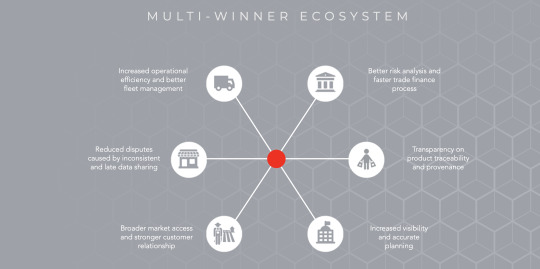
Better risk analysis and faster trade finance process
Increased operational efficiency and better fleet management
Reduced disputes caused by inconsistent and late data sharing
Transparency on product traceability and provenance
Broader market access and stronger customer relationship
Increased visibility and accurate planning
OBORTECH's Smart Hub VS Traditional systems

THE SMART HUB OFFERS
Blockchain and cloud powered communication hub
Accessible via easy to use web and mobile user interfaces, and an open API, the Smart Hub brings together supply chain actors, and enable their supply chains to share information, collaborate, conduct data analysis, and validate product traceability in real-time on a trusted platform.
Tamper-proof, unified and online document exchange
The Smart Hub allows secure sharing and exchange of documents with supply chain partners using blockchain powered version control. Authorized parties to any shipment can immediately see when changes have been made, and by whom, along a shipment journey.
IoT based real-time visibility and tracking
IoT sensors are installed on containers/trucks and transmit data to the Smart Hub dashboard to track valuable shipments, monitor their key physical measurements, and protect high-value products against theft. A client gets positioning data for shipment in real-time, irrespective of the shipping carrier they choose.
Open and decentralized networking marketplace
Based on the blockchain based trusted network established among the Smart Hub participants, the marketplace ecosystem will enable verification and scoring of stakeholders in supply chain without the need for third-party credentials. Moreover, the marketplace is a blockchain based decentralized ecosystem that enables buying, selling and exchanging of services without the need of intermediaries among the users.
OBOT DEFI
FOR DIGITAL SUPPLY CHAIN
Smart Hub transaction fee
OBOT token will be used for paying Transaction fee of bundled services offered by the Smart Hub. Every transaction revenue received by OBOT is split in the following way: 5% for token burns, 20% for marketing & community building, 5% for Non-Profit activities, and 70% for Network Admin fee.
Contract bonus
OBOT token can be used for promoting contract performances between the Smart Hub users. Users collaborating via the Smart Hub can convert some portion of their contract funding into OBOT tokens and allocate them in Escrow Contract as a bonus payment.
Crowdfunding
Members of the Smart Hub can launch crowdfunding activities to OBOT token holders in the Smart Hub Marketplace. It will be done either by lending with algorithmic interest rate protocol based on calculation of member score/rating or by pledging (similar to Kickstarter) between creators and backers based on Escrow Contract and performance tracking in the Smart Hub’s blockchain network.
Exchanging services
OBOT token will be used in the Smart Hub Marketplace when its users exchange services among them. The Smart Hub Marketplace is a blockchain based decentralized ecosystem that enables buying, selling and exchanging of services without the need of intermediaries among the Smart Hub users.
Member rewarding
The Smart Hub members will be rewarded by OBOT tokens based on their score/rating in the Marketplace. Members will be scored/rated by various ways based on blockchain data and performance histories in the Smart Hub network.
Governance
OBOT token allows holders to participate in Governance decisions of the Smart Hub Marketplace. They can exercise voting rights on policies of member enrollment, service exchanges, and crowdfunding activities of the Marketplace.
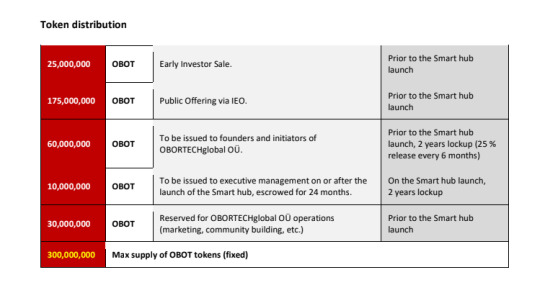
With OBOT tokens, the Smart Hub users can enjoy rewards like express delivery and extra care of products during shipments via the Smart Hub network. Get your OBOT tokens today by participating in our IEO
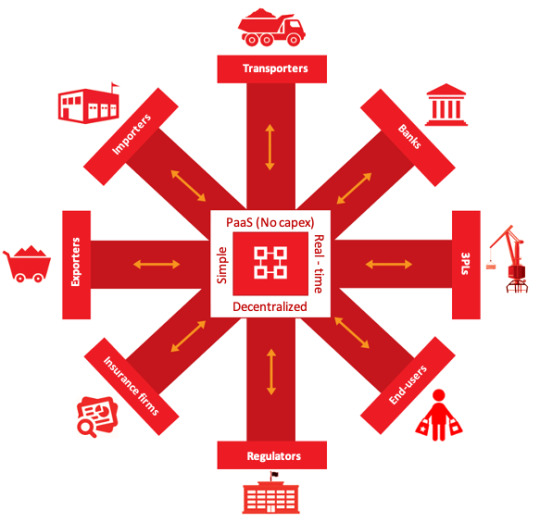
The manual and paper based processes often used in Supply Chain Industries are time consuming and also result in a lot of extra maintenance costs.
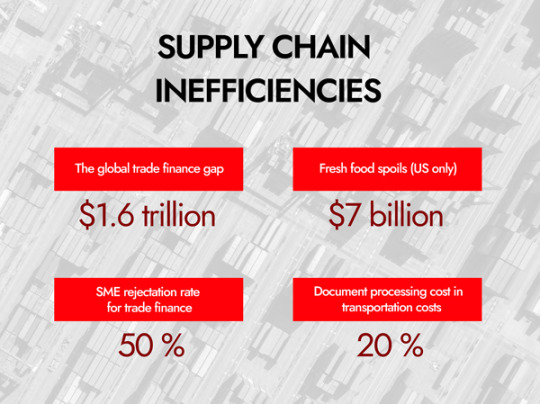
IEO starts on Probit from 10th March 2021
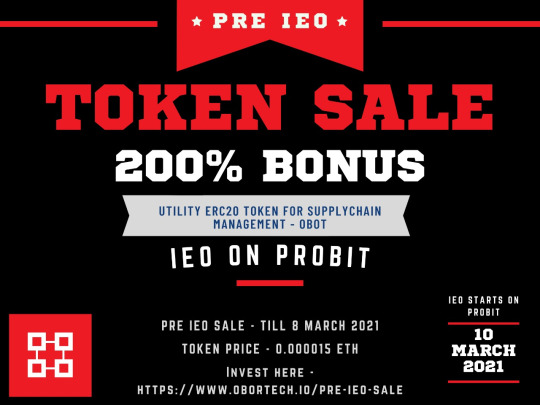
Starting price: ETH 0.000015
Invest upto 1 ETH, get 50% more bonus OBOT tokens
Invest between 1ETH - 2 ETH, get 100% more bonus OBOT token
Invest more than 2 ETH, get 200% more bonus OBOT tokens
ROAD MAP

TEAM
Tamir Baasanjav: CEO and Founder
He is specialized in project management and strategic communication. He had worked in managerial and expert positions of prestigious international development, government and business organizations such as an agency funded by Government of the United States for transportation and energy efficiency fields, Knowledge Hub project of Swiss Agency for Development and Cooperation on sustainable mining, and the biggest corporate bank of Mongolia. He also has 10 years of experience in UX and product designs. He won the global product design contest held by Adidas.
He designed the Smart Hub concept and its business strategy. He manages the project and leads the product design and marketing/communication.
Enkhbat Dorjsuren: Logistics Lead and Co-founder
He has 20 years of experience in logistics and transportation sector. He is a CEO of Mongolian Express LLC, one of the largest inland transport and logistic companies in Mongolia. He has extensive network in Mongolian transportation and logistics sector.
He established the project’s partnerships in the transportation sector and leads partnership development in Mongolia and Euro-Asia
Tungalag Sukhbat: CFO
She is a finance and investment professional more than 20 years of experience. She has worked in different domains including strategic and financial consulting, central banking, corporate banking, asset management, and multilateral development programs in managerial and expert positions. She achieved CFA Charter in the UK and is a member of the CFA Institute. Moreover, she is a Certified Business Appraiser of Mongolia.
She developed the business plan as well as financial modelling and analysis of the project. She leads financial management and analysis of the project.
Zoljargal Dashnyam: Chief Counsel
She has extensive experience in corporate law and private equity. Her portfolio of clients includes investment banks, multinationals, mining companies, and investment funds. She graduated Harvard Law School in Master of Laws. She was ranked as a top-tier lawyer in Mongolia for 9 years. She is a Senior Partner of the leading law firm in Mongolia, DB>S.
She is in charge of the governance model development of the Smart Hub and legal activities of the project.
Alok Gupta: Blockchain Architect
He is a certified blockchain developer with over 12 years of experience in application development and deep knowledge of Hyperledger Fabric architecture and functionalities. He was in top 5% of Blockchain Architecture Design course conducted by IBM and IIT, a top technology institute in India. He developed various blockchain projects and applications in supply chain, real estate registry, health insurance, etc.
He developed the blockchain architecture and application of the prototype system. He leads the blockchain (Hyperledger) architecture and application development of the project.
Maxim Prishchepo: Blockchain Architect
He is a blockchain architect with more than 6 years of experience in blockchain development and 20 years of experience in architecture designs of complex financial IT systems. He is a qualified analyst in crypto banking & finance. He worked as a core blockchain developer and architect for Energi, 0chain, and Wagerr projects. His main areas of specialization are Bitcoin, Ethereum, PIVX, ZCash and other open-source based blockchain solutions.
He developed the Ethereum smart contract of the project. He leads the token payment system and Ethereum blockchain development of the project.
Mauro Andriotto: Adviser
He is internationally recognized as one of the leaders in blockchain and Security Token Offering (STO). He is a professor of Corporate Finance and University of Geneve – UBIS. He is an Independent Expert at the European Commission for Horizon 2020 where he approves public grants for startups. He is also the former quantitative leader at EY for the South Europe area.
He advises the project on European market and fundraising
Garry Pinder: Adviser
He is a Managing Director of Intermodal Solutions Group (ISG). ISG is a global company supplying container rotation systems for the mining, grain and ship loading industries. It operates in 12 countries and wide network of client base in South American region.
He advises the project on South American market of containerized transportation of agricultural and mining products.
Ulf Henning Richter: Adviser
He specialized in logistics and infrastructure technologies of Europe, China, and Africa regions. He is a member of China Highway & Transportation Society. He is also a Chairman of LUKOIL, Hong Kong branch.
He advises the project in partnership development in China.
For more information, please follow the links below:
Website: https://www.obortech.io/
WHITEPAPER: https://drive.google.com/file/d/1a9vax2925irEnR5yUVx8ZAGo84ISLEre/view
Telegram: https://t.me/OBORTECH
Twitter: https://twitter.com/OBORTECHhub
Facebook: https://www.facebook.com/OBORTECH
Linkedin: https://www.linkedin.com/company/obortech
Medium: https://blog.obortech.io/
Youtube: https://www.youtube.com/channel/UCQxPIavuaCHfdpGsT8_hFkw
AUTHOR:
Bitcointalk Username: Manuel Akanji
Bitcointalk Profile: https://bitcointalk.org/index.php?action=profile;u=2954998
Telegram Username: @Manuelakanji777
ETH Address: 0x176a48a2Eb8FF8dfa46e58741E4A7b642C90F512
1 note
·
View note
Text
MEXC Exchange Lists Heroes & Empires (HE) - Deposit & Trade to win 20,000 HE!
MEXC Global Exchange lists Heroes & Empires (HE) in the Assessment Zone and open trading for the HE/USDT trading pair. The specific timeline is shown below.
Deposit & Withdrawal: Opened
HE/USDT Trading: 2021-10-27 14:00 (UTC)
*Note: Prices may fluctuate greatly for projects listed in the Assessment Zone, please be cautious and be aware of hidden risks of delisting.
HE Deposit and Trading Contest - 20,000 HE to be Won
To reward the community members for their support, the Heroes & Empires team has decided to launch a Deposit and Trading Contest with 20,000 HE to be won! The details are the following:
Activity 1: Deposit HE and claim from a 5,000 HE prize pool
Activity Period: 2021-10-26 14:00 (UTC) - 2021-10-30 15:00 (UTC)
During the activity period, users who deposit HE with a net deposit of no less than 100 HE, could share a total of 5,000 HE prize pool in proportion to net deposit amount
Activity 2: HE Trading Contest - 15,000 HE to be won
Activity Period: 2021-10-27 14:00 (UTC) - 2021-10-30 15:00 (UTC)
1) Grand Prize
Users who trade HE during the activity period will be ranked based on their trading volume. The top 10 users with the largest trading volume (meeting min. trading volume requirement of 5,000 USDT) can share a 10,000 HE prize pool in proportion to their trading volume respectively.

2) Participation Prize
All HE traders (excluding the top 10 winners) with min. trading volume meeting 300 USDT are eligible to share a 5,000 HE prize pool in proportion to their trading volume respectively.
Note:
1. The reward will be distributed within 7 days after the activity ends, users can check it in [D/W History] - [Other records].
2. Net deposit = Deposit - Withdrawal; Valid Trading Volume = Buys + Sells. Transfer amount between accounts will be excluded.
3. Users participating in this event must complete the required KYC verification before the end of the event to be deemed eligible to claim the rewards.
4. Wash trading and any cheating conduct are prohibited. Otherwise, MEXC has the right to deprive the prize, even freeze the account.
5. This activity was initiated by the HE Network project party, and the rewards are provided by the project party. All participating users are deemed to participate voluntarily. The activity does not constitute any investment advice.
6. MEXC reserves the final right to interpret.
Project Details
(This information is provided by the project party. Strictly for references only.)
Project Name: Heroes & Empires (HE)
Official Website: https://heroesempires.com
Block Explorer (BEP20): https://bscscan.com/token/0x20d39a5130f799b95b55a930e5b7ebc589ea9ed8
Current Total Supply: 1,000,000,000 HE
Twitter:https://twitter.com/HeroesEmpires
Telegram: https://t.me/HeroesEmpires
Blog: https://blog.heroesempires.com
Whitepaper
Brief Introduction:
Heroes & Empires is one of the first NFT gaming projects that combines the modern RPG gameplay and blockchain technology. Besides the Play2Earn element, the game also provides a fun gaming experience through high-end graphics, innovative auto-battler gameplay, and a competitive PvP system
Risk Warning
Cryptocurrency investment is subject to high market risk. Please make your investments cautiously. MEXC Global will make the best efforts to choose high-quality tokens, but will not be responsible for your investment losses. As a digital asset trading platform that respects the community, MEXC adheres to the principle of truthful, transparent and fair trading, with no malicious intent. We are committed to providing users with a service that is safer, more efficient, and more reliable for the trading of digital assets.
0 notes
Photo

@shadidesignxyz 1st place. Natural force: part of parts · International Design Workshop 1 · Interstellar Shadi Design @shadidesignxyz #shadidesignxyz Authors: Gonzalo Mazzey @gonzalomazzey · Chile Metropolitan Technological University Architecture student Leonela Berrocal @ leomily1917Peru Pontifical Catholic University of Peru Architecture student Director: Kevin Abanto @kevinabantoarkitekte Jury: Hazel villena LARGE - Bjarke Ingels Group, Columbia GSAPP Diego Ramirez UNStudio, IaaC Betty chavez UCL Bartlett, Barclay & Crousse Architecture Work flow: Autodesk Maya + McNeel Rhinoceros + Cinema 4D + Magicavoxel + Adobe After Effects + Adobe Premiere Pro + Adobe Photoshop Complete project available in the link of the biography (Behance + Flickr + Youtube): https://linktr.ee/shadidesignxyz Shadi Design is an interdisciplinary advanced design school that integrates science, technology, music, film, photography & more. Develops workshops based on films, documentaries, novels, history, criticism, video games, literature, theories, philosophy, etc. It encourages critical thinking and broadens the landscape of design and research through the use of cutting-edge technologies. Aimed at students & professionals of architecture, design, arts, engineering, photography, related careers and the general public. Open to international participation in virtual mode by Zoom. Procedural: contest modality + integration into the project portfolio + job market + calls + virtual exhibitions + publications in the media + community. All inquiries about the school, publications in the media & future editions of our workshops, will be resolved in the following media: whatsapp and telegram: +51986308101 email: [email protected] social networks: https://linktr.ee/shadidesignxyz © copyright Year 2021 #design #next_top_architects #architecture #archdaily #architecture_hunter #archicompetition #designchallenge https://www.instagram.com/p/CNAof1jD_9c/?igshid=176w98gex7s04
#shadidesignxyz#design#next_top_architects#architecture#archdaily#architecture_hunter#archicompetition#designchallenge
0 notes
Text
MASSIVE CRYPTO NEWS! Uniswap, TrustSwap, FalconSwap, Chainlink, Quant Network, ShareRing

youtube
CEO of MicroStrategy Extremely Bullish on Bitcoin | Uniswap UNI giveaway | FalconSwap FSW Partners with TrustSwap | Chainlink Price Predictions | ShareRing SHR Joins BSN | Quant Network QNT Treasury Model Guide
CRYPTOCURRENCY AND BITCOIN VISA DEBIT CARD – GET $50 FREE ON ► CRYPTO.COM https://platinum.crypto.com/r/ab *Code is AB
Get $10 Bitcoin bonus for trading $100 and more at Binance till September 19, 2020. ► https://www.binance.com/en/register?ref=UAMKZ47P *Code is UAMKZ47P
TRADE ON AAX, WORLD’S FIRST CRYPTO EXCHANGE POWERED BY LSEG TECHNOLOGY ► AAX EXCHANGE https://www.aax.com/invite?inviteCode=zpqm9Fn03yVG
CRYPTOCURRENCY MARKET PRICES AND DATA ► COINGECKO https://www.coingecko.com/en
TRADE BARCELONA FC, JUVENTUS AND UFC TOKENS ON CHILIZ EXCHANGE ► https://www.chiliz.net/register/FZAkA1 *Code is FZAkA1

NOTE If you use the above referral links, we receive a commission at no additional cost to you.

TOP CRYPTO NEWS – https://www.altcoinbuzz.io

FREE NEWSLETTER – http://eepurl.com/dnIEz1

TWITTER – https://twitter.com/Altcoinbuzzio

FACEBOOK – https://www.facebook.com/altcoinbuzzio

TELEGRAM – https://t.me/joinchat/DLi8Ug8negQrbwYO-oqNRA

TIMESTAMPS 0:00 Intro 1:20 Market Update (-5.5%) 3:02 CEO of MicroStrategy Bullish on Bitcoin 7:07 $50 Uniswap (UNI) giveaway 8:00 FalconSwap (FSW) Partners with TrustSwap (SWAP) 9:57 Chainlink (LINK) to grow 300-400%? 12:41 ShareRing (SHR) Joins China’s BSN 15:48 Quant Network (QNT) Treasury Model Guide
References:
On September 14, 2020, MicroStrategy completed its acquisition of 16,796 additional bitcoins at an aggregate purchase price of $175 million. To date, we have purchased a total of 38,250 bitcoins at an aggregate purchase price of $425 million, inclusive of fees and expenses.
— Michael Saylor (@michael_saylor) September 15, 2020
#Bitcoin is a swarm of cyber hornets serving the goddess of wisdom, feeding on the fire of truth, exponentially growing ever smarter, faster, and stronger behind a wall of encrypted energy.
— Michael Saylor (@michael_saylor) September 18, 2020
This is the sound cybernetic hornets make as they protect the #Bitcoin network while simultaneously helping to make Oil & Gas producers more efficient with their waste gas. pic.twitter.com/I2X9iBdyxw
— Marty Bent (@MartyBent) September 20, 2020
To acquire 16,796 BTC (disclosed 9/14/20), we traded continuously 74 hours, executing 88,617 trades ~0.19 BTC each 3 seconds. ~$39,414 in BTC per minute, but at all times we were ready to purchase $30-50 million in a few seconds if we got lucky with a 1-2% downward spike.
— Michael Saylor (@michael_saylor) September 18, 2020
We acquired 21,454 BTC via 78,388 off-chain transactions, then secured it in cold storage with 18 on-chain transactions. #Bitcoin scales just fine as a store of value.
— Michael Saylor (@michael_saylor) September 17, 2020
youtube
$50 $UNI #Giveaway!


WINNER gets 10 $UNI ≈$50!


Like & Retweet

Follow @Altcoinbuzzio

Reply with ANY fact/opinion about @UniswapProtocol

Ends September 25!

Good Luck

#Crypto #Contest #Altcoin #Bitcoin #DeFi
— Altcoin Buzz (@Altcoinbuzzio) September 18, 2020
FalconSwap x Trustswap!


This mutually beneficial integration will open up synergies for @Trustswap and FalconSwap in building products that will open doors for long term growth and adoption of the DeFi services.

Read more: https://t.co/QOL4ck0pos $FSW $SWAP $ETH
— FalconSwap (@Falcon_Swap) September 18, 2020
https://medium.com/falconswap/falconswap-x-trustswap-b6d3dbb88fba
One protocol, multiple value additions! $FSW https://t.co/ulvLKx5w79
— FalconSwap (@Falcon_Swap) September 21, 2020
ChainLink @chainlink is on a path towards experiencing returns similar to an early Bitcoin of 300 – 400% per year. $LINK price is very much linked to the adoption of the ChainLink network.
More crypto projects continue to integrate Chainlink Technology.https://t.co/A2NNyUrU1Q
— ƊÓȠ. (@Don_ChainLink) September 20, 2020
Crypto Analyst: ChainLink’s Annual Returns Could Mimic an Early BTC

We are thrilled to announce that ShareRing has joined @bsnbase !
The BSN Foundation’s mission is aligned with ours: to drive worldwide adoption of blockchain technology for businesses and users of all sizes.
Read more https://t.co/RdLETiPIRY#adoption #blockchain #SHR #BSN
— ShareRing (@ShareRingGlobal) September 16, 2020

AMA Throwback Series July 2020
CEO @TheRealTimBos estimates there to be at least a few million ShareRingID accounts by the end of 2020!

AMA here: https://t.co/d4Q9mGidhp#MassAdoption #Travel #Identity #blockchain pic.twitter.com/VEDiIEDQ1K
— ShareRing (@ShareRingGlobal) September 20, 2020
https://www.forbes.com/sites/michaeloloughlin/2020/09/20/encouraging-signs-as-china-welcomes-more-international-blockchain-players-to-ecosystem/#2d5c64354bc4 https://www.altcoinbuzz.io/reviews/altcoin-projects/quant-network-qnt-treasury-model-guide/
Disclaimer: The information discussed by Altcoin Buzz is not financial advice. This is for educational and informational purposes only. Any information or strategies are thoughts and opinions relevant to accepted levels of risk tolerance of the content creators/reviewers and their risk tolerance may be different than yours. Altcoin Buzz is not responsible for any losses that you may incur as a result of any investments directly or indirectly related to the information provided. Please do your own due diligence and rating before making any investments and consult your financial advisor. The researched information presented we believe to be correct and accurate however there is no guarantee or warranty as to the accuracy, timeliness, completeness. Bitcoin and other cryptocurrencies are high-risk investments so please do your due diligence. Copyright Altcoin Buzz Pte Ltd. All rights reserved.
The post MASSIVE CRYPTO NEWS! Uniswap, TrustSwap, FalconSwap, Chainlink, Quant Network, ShareRing appeared first on BLOCKPATHS.
source https://blockpaths.com/commentaries/massive-crypto-news-uniswap-trustswap-falconswap-chainlink-quant-network-sharering/
0 notes
Text
Campaign Chronicles
What Happens if Donald Trump Fights the Election Results?
Stealing a Presidential election in America is difficult, but it has been done before.
— By Eric Lach | August 21, 2020 | The New Yorker

Donald Trump has disputed the popular-vote results of a Presidential contest he won. Now he leads a concerted effort to undermine public confidence in the upcoming election.Photograph by Saul Loeb / Getty
On the night of November 7, 1876, as the results of the Presidential election between Samuel Tilden, the Democratic governor of New York, and Rutherford B. Hayes, the Republican governor of Ohio, began to come in, America, in its centennial year, was barely holding together. Reconstruction was faltering. The economic collapse that followed the Panic of 1873 had left millions out of work, and provoked strikes and labor unrest across the nation. The outgoing Republican Administration of Ulysses S. Grant had been embroiled in a series of corruption scandals. A few months earlier, Sioux warriors had defeated General George Custer and his troops at Little Bighorn. Hayes, whom Henry Adams described as a “third-rate nonentity,” had earned the Republican nomination, in large part, by being the one candidate all factions of the Party could agree on. Tilden and the Democrats seemed poised for an easy victory. As the historian Eric Foner writes in “Reconstruction,” his history of the period, “political corruption and the depression became Tilden’s watchwords; issues many Republicans feared would suffice to carry the election.”
Before Election Day was over, it was clear that Tilden, who, in his previous career as a Gilded Age corporate lawyer and reorganizer of bankrupt railroad lines, had earned the nickname the Great Forecloser, would comfortably win the popular vote. He needed only a single vote in the Electoral College to put him over the top, and results were outstanding in Florida, South Carolina, and Louisiana, where white citizens routinely used violence, intimidation, and fraud to keep their Black neighbors, most of whom were loyal to the Republican Party of Abraham Lincoln, from voting. With the prospect of Democrats taking the White House through disenfranchisement at hand, Republicans moved to steal the election outright. “With your state sure for Hayes, he is elected,” Party leaders said in an Election Night telegram to their cronies in the three Southern states. “Hold your state.”
In Florida, the two Republicans on the three-person election board—Samuel McLin, the Florida secretary of state, and Clayton Cowgill, the state comptroller—systematically approved and rejected results, district by district, to swing the election in their party’s favor. “If the canvassing board had simply accepted all the local returns, Tilden would have prevailed by 94 votes,” Edward Foley, an election-law professor at Ohio State University, writes in “Ballot Battles,” a survey of disputed American elections. “In its decisive 2–1 rulings, however, the board selectively invalidated Tilden-favoring returns because of technicalities, while refusing to invalidate Hayes-favoring returns despite clear evidence of actual fraud.” In this way, a narrow Tilden lead was transformed into a narrow Hayes lead. Similar events unfolded in South Carolina and Louisiana. “The result was manufactured by a deliberate manipulation of the count,” Foley writes.
Democrats were outraged. What ensued is a mostly forgotten episode of American misgovernment that has lately been haunting Foley and other academics, as well as a loose network of bipartisan ex-officials, activists, and think-tank types, who are now contemplating the potential for a disputed election in the present day, at our own fraught political moment. The three Southern states in 1876 each sent Congress two pieces of paper, one from Republican electors certifying that Hayes had won the election, the other from Democratic electors certifying that Tilden had. The crisis these pieces of paper provoked, as Congress tried to reconcile their competing claims, pushed America’s constitutional order to its breaking point—or perhaps, looked at from another angle, it was a reflection of an order that had already broken down.
The Twelfth Amendment, which lays out the procedure for electing the President and Vice-President, says nothing about what Congress should do in the event that states send competing election certificates. Republicans controlled the Senate, and Democrats controlled the House. The two chambers established a commission to try to break the impasse. The dispute went on for months. (Back then, Administrations were inaugurated in March.) With Inauguration just days away and the prospect looming of a country with two people claiming the Presidency and no actual President, House Speaker Samuel Randall presided over a debate described decades later in a history of the crisis as “probably the stormiest ever witnessed in any House of Representatives.” Congressmen reached for their revolvers, and women in the gallery, “fearing a free fight,” ducked out of the chamber.
The tension broke only after William Levy, a Democratic representative from Louisiana who had been in on negotiations between the Southern states and Hayes’s camp, finally signalled that a deal had been struck. Tilden and the Democrats would concede the White House to Republicans, allowing Hayes to effectively steal back the election. Rising to speak in the House chamber, Levy called upon his fellow-Democrats “to join me in the course which I feel called upon and justified in pursuing.” The price that Democrats exacted from Republicans, though, was incalculably high: the drawdown of federal troops in the Southern states, the end of Reconstruction, and the consignment of Black citizens to a century of violent repression. “The negro will disappear from the field of national politics,” The Nation wrote at the time. “Henceforth, the nation, as a nation, will have nothing more to do with him.”
The Hayes-Tilden crisis was resolved, Foley told me recently, “at the expense of America’s commitment to its own citizens.” Unlike the 2000 election, between George Bush and Al Gore, where the dispute was contained in the courts, the 1876 dispute spilled out into the broader political system, and its outcome was openly determined by a naked struggle for power between the two ruling parties. “Because many of us have a living memory of 2000, we think that any election dispute is going to look like 2000,” he said. “Where, in fact, I think that kind of gives us a false sense of what might happen. I think there are now conditions in place that may cause this year’s election to be more like 1876.”
It has been difficult, throughout Donald Trump’s Presidency, to immediately know which of his declarations represent constitutional danger and which are merely attention-seeking bluster. “I think mail-in voting is going to rig the election,” Trump told Fox News’s Chris Wallace during a recent White House interview. When Wallace asked if the President was suggesting that he might not accept the results, Trump, with hands raised, replied, “I have to see. I’m not going to just say yes.” The President’s intermittent musings about postponing the November election have so reliably set off rounds of breathless news coverage that Marc Elias, one of the Democratic Party’s go-to election lawyers, was compelled to write a blog post in March titled “No, Trump Cannot Move the General Election.” Similarly, in response to the persistent speculation that an electorally defeated Trump would spend Joe Biden’s Inauguration Day holed up in the Lincoln Bedroom like Tony Montana at the end of “Scarface,” the Biden campaign in July issued a pithy statement saying, “the United States government is perfectly capable of escorting trespassers out of the White House.”
But Trump’s threats about rejecting the results come November are not idle. In 2016, Trump disputed the results of an election he won, ludicrously claiming that his popular-vote shortfall was the result of illegitimate ballots cast by millions of undocumented immigrants. Four years later, the President is at the head of a concerted effort to undermine public confidence in the upcoming election. Trump has denounced efforts to expand the mail-voting systems that will allow millions of people to cast their ballots safely in this pandemic year. He has ignored calls to provide election administrators with much-needed additional funding to safeguard voters, staff, volunteers, and the vote-counting process. And he has overseen the crippling of the U.S. Postal Service at a time when its work will be critical to the success of the election. “It’s just a question of overload,” Richard L. Hasen, a law professor at the University of California, Irvine, and the author of “Election Meltdown: Dirty Tricks, Distrust, and the Threat to American Democracy,” said. “We have problems with voting machines; we have problems with incompetent election officials. There is foreign interference. Layer on top of that the covid-19 crisis. Layer on top of that a President who is a norm breaker.”
In June, the Transition Integrity Project, a newly formed group devoted to evaluating how a disputed election might unfold, hosted a series of “war games” to play out various scenarios for what might happen on and after November 3rd. Zoe Hudson, a former Open Society Foundation analyst who serves as the director of the project, told me that the idea was to “socialize” potential risks. “Surprise doesn’t work for us,” she said. “We really need people to understand that this will be an unusual election year.”
More than a hundred people participated, most of them prominent names in academia, politics, and the media—Foley was there, as were the former Hillary Clinton campaign chairman John Podesta, former Michigan governor Jennifer Granholm, and former Republican National Committee Chairman Michael Steele. Participants assumed roles as members of the Trump or Biden campaigns, state officials, and the media. The games, which were played under the Chatham House rule—participants are allowed to discuss what happened as long as they don’t reveal who in the room said or did what—proceeded by turns, with certain developments determined by dice rolls. “One of the big takeaways on all sides is that what you have here potentially is a situation where neither side accepts a loss,” Adam Jentleson, a former aide to Senate Majority Leader Harry Reid who participated in the war games, told me. “And that’s a very difficult circle to square.”
While Americans have grown accustomed to Election Nights that unfold like Super Bowls—tune in at 5 p.m. for the pregame and turn off the set at midnight after one side or the other hoists the trophy—the surge in absentee voting brought on by the coronavirus pandemic will likely frustrate that expectation this year. Counting absentee ballots is a slow, laborious process, and, in a number of states, the counting cannot begin until the election is over. In primary elections this spring and summer, states without past experience counting large numbers of absentee ballots have struggled to process them. In New York, the state Board of Elections took six weeks to declare Representative Carolyn Maloney the winner of the congressional Democratic primary in the state’s Twelfth District. Her challenger in the race, Suraj Patel, filed a lawsuit, citing a number of issues with the count, including thousands of mail-in ballots being disqualified and tens of thousands being sent out too late for voters to realistically return on time. Maloney suggested that Patel was playing into Trump’s hands by questioning the legitimacy of an election. Patel and his campaign understandably bristled at the charge. Count every vote, they have insisted. Address the problems now so that they don’t plague us in November.
It’s one thing for an election dispute to play out in a little-noticed congressional primary. When similar disputes broke out in the Transition Integrity Project’s games, with the future of the entire country on the line, the effect was pure mayhem. In the first scenario, the results from three states—North Carolina, Michigan, and Florida—remained too close to call for more than a week. On Election Night, Trump’s campaign called on Biden to concede, citing in-person-voting returns, which looked good for the President. But as the absentee ballots in these states were counted, the numbers swung toward Biden. This was “blue shift,” a phenomenon observed by Foley and other academics in recent elections, wherein in-person-vote totals have tended to skew Republican, while absentee voting has skewed Democratic. Blue shift is what kept the Democratic House wave in 2018 from being immediately apparent on Election Night—the mail votes cast in California that fall took weeks to count, an outcome that former House Speaker Paul Ryan, a Republican, described at the time as “bizarre.” This year, with Trump explicitly making mail voting a partisan issue, the blue shift is likely to be especially pronounced. And Trump is, in turn, expected to denounce this easily explainable phenomenon as nefarious.
As the votes were being tallied in the game, Trump pounced. The team playing as his campaign called on the Justice Department to use federal agents to “secure” voting sites and tried to enlist state Republican officials to stop the further counting of absentee ballots. The Biden team, in response, called for every vote to be counted and urged its supporters to attend rallies calling for the same. During subsequent turns, Trump tried to federalize the National Guard, and both parties sought to block or overturn results in key states. Eventually, North Carolina was declared for Biden and Florida was declared for Trump, leaving Michigan as the deciding state—there, a “rogue individual” destroyed ballots believed to be favorable to Biden, leaving Trump with a narrow lead. Michigan’s Republican-led legislature certified Trump’s victory, but the state’s Democratic governor, Gretchen Whitmer, refused to accept the result, citing the sabotage, and sent a separate certification to Congress.
It was 1876 all over again. Both campaigns called for their supporters to take to the streets. Trump invoked the Insurrection Act. Republicans in Congress declared that Vice-President Mike Pence, as president of the Senate, was entitled to choose which certification from Michigan to accept as legitimate. Democrats, of course, rejected that argument. “There was no clear resolution of the conflict in the January 6 joint session of Congress,” the game summary reads. “The partisans on both sides were still claiming victory, leading to the problem of two claims to Commander-in-Chief power (including access to the nuclear codes) at noon on January 20.” The game ended there.
Another scenario, in which Trump won a clear victory in the Electoral College but lost the national popular vote by an even wider margin than in 2016, also ended in chaos. Biden withdrew his Election Night concession and asked the Democratic governors in Wisconsin, Michigan, and North Carolina for recounts. The governors in Wisconsin and Michigan took the 1876 course again, sending a slate of electors to Congress that conflicted with those sent by their states’ Republican-controlled legislatures. Republicans, unsuccessfully, tried to cajole moderate Democrats to break from their party and back Trump’s victory. “At the end of the first turn,” the summary reads, “the country was in the midst of a full-blown constitutional crisis.” Congress, once again, failed to resolve the standoff before Inauguration Day. “It was unclear what the military would do in this situation,” the transcript says. According to the Times, near the end of this scenario, Podesta, the former Clinton campaign chairman, called on California, Oregon, and Washington to secede from the Union.
Even a scenario that led to a peaceful transfer of power was, at certain moments, politically perilous. In one game, Biden won the election by a narrow but clear margin. Trump’s campaign persuaded the Republican-controlled legislatures in Michigan and Pennsylvania to send Congress conflicting election certifications. Attorney General William Barr announced that the Justice Department would begin investigating “voter fraud” and took steps to stop ballot counting. But, as the game went on, Senator Mitt Romney convinced three of his fellow Republican senators to break ranks and support Biden. A dice roll determined that four million people would participate in pro-Biden street demonstrations. The Joint Chiefs of Staff discussed resigning in protest at Trump’s increasingly desperate behavior, and those discussions were leaked to the press. As power began to slip away from the President, right-wing media turned increasingly toxic, and his Administration devolved into a frenzy of document destruction and corrupt pardonings. Biden called on the House and Senate Intelligence Committees to investigate foreign interference in the election and announced that moderate Republicans, including the governor of Massachusetts, Charlie Baker, would serve in his Cabinet. The game ended with the Democratic Party beginning to investigate Trump and his family.
These war games were hypothetical imaginings of extraordinary circumstances. But an election in a pandemic year with a President declaring in advance that the vote will be rigged are extraordinary circumstances. “One big takeaway is that leaders really need to know what exactly their powers are, and what the powers of others are, and think through some of these options in advance,” Rosa Brooks, a law professor at Georgetown University who helped convene the Transition Integrity Project, told me recently. “Because if things go bad, they’ll go bad very quickly, and people will have to make decisions in an hour, not in a week.”
The contours of the upcoming election are already being fought over in the courts. Since the 2000 election, with its hanging chads and butterfly ballots, America has seen an explosion of election-related litigation, from an average of ninety-four lawsuits a year to an average of two hundred and seventy a year, according to an analysis by Hasen, the author of “Election Meltdown.” This year, there have already been some two hundred election lawsuits filed over covid-19-related issues alone. In May, the Trump campaign and the Republican National Committee doubled their legal budget, to twenty million dollars. “Bush v. Gore exposed shortcomings in our system in a very visible way,” Rebecca Green, an election-law professor at William & Mary Law School, said. “And so people started pushing back and testing it.” This isn’t necessarily a bad thing, Green said. “We do disputed elections in this country. We have processes in place. We have law. It’s not the Wild West where we’re left without direction on how this should unfold.” She added, “I really worry about public confidence being undermined by this constant drumbeat of meltdown.”
The biggest cases so far have centered on mail voting. At the state level, efforts to address this year’s unprecedented voting challenges have largely been bipartisan efforts—as many as forty-five states will allow voters to mail in their ballots for the November election. But in the courts, the two parties’ overarching national positions come down to this: Democrats are trying to make voting by mail as easy as possible, and Republicans are fighting to prevent that. Caught in the middle are election administrators, the local officials tasked with organizing and processing our voting systems. The Brennan Center for Justice at N.Y.U. has estimated that administrators would need an additional four billion dollars in funding to safeguard the vote during the pandemic. In the Coronavirus Aid, Relief, and Economic Security Act, Congress allocated four hundred million dollars for election preparations. The shortfall will likely mean, in many cases, fewer polling places, longer lines, and slower processing of absentee ballots. Administrators have also reported trouble recruiting volunteers—the battalion of retirees that normally mind our polls and count our ballots—because many of them are wary of exposure to the virus. In normal years, election administrators and the volunteers they rely on are prone to mistakes. This year, all these issues make slow counts and frustrated voters even more likely—and create the conditions for one side or the other to dispute the outcome.
Of course, Trump has increased the chances for such a dispute by undermining public trust in the system itself. Nowhere has this dynamic been more insidious than with the Postal Service. Conservatives have been targeting the agency for cuts for years, and recent Trump Administration decisions—spearheaded by the new Postmaster General, Louis DeJoy, who is a major Trump donor—have caused a mail slowdown around the country. Those efforts have collided with an election that will rely on the Postal Service more than any in American history. Trump has made the connection explicit. “They want three and a half billion dollars for something that’ll turn out to be fraudulent,” he said earlier this month, about the Democrats’ position in the latest round of negotiations over pandemic relief. “They need that money in order to make the Post Office work so it can take all of these millions and millions of ballots.” The fear and distrust that Trump has sown has meant that, when the Postal Service recently sent a letter to states warning that some of their absentee-ballot application and filing deadlines were “incongruous with the Postal Service’s delivery standards” and too close to Election Day to guarantee timely delivery—a concern that independent election experts have raised for years—state officials grew worried that the federal government was preëmptively preparing to blame them for problems in November. “I think that many people were surprised by the tone of the letter,” Tammy Patrick, an adviser at the Democracy Fund who previously served as an election administrator in Maricopa County, Arizona, said. “I have never seen the Postal Service throw a customer under the bus before—and certainly not when the votes of American citizens are on the line.” (On Friday, DeJoy is scheduled to appear at hearings before congressional Democrats.)
After Election Day, the lawsuits are expected to shift to questions about ballot counting. Absentee ballots present bureaucratic problems in ways that in-person voting doesn’t. Even in normal election years, a large number of absentee ballots are disqualified. The reasons range from signature matching, a notoriously unreliable process, to disputes over “voter intent,” where individual ballots are evaluated for stray markings, and ballots that arrive after the deadline. “In a lot of cases, the law does give judges leeway,” Green said. “And the unenviable place where they end up is, do I stretch the law to enfranchise as many people as I can, or do I read the law strictly and end up disenfranchising people?” Already this year, the disqualification rate seen in some states during the primaries has been alarming. “The biggest potential disaster is that one candidate wins because so many votes are thrown out,” Hasen told me. “More votes are lost to incompetence than anything else.”
Rachana Desai Martin, who is leading the Biden campaign’s voter-protection efforts, told me that the campaign’s energy was currently focussed on voter education. “We want to make sure that we’re doing everything we can to put out correct information about how to vote, and that means both by mail and also in person, early and on Election Day,” Martin said. (Hasen, for his part, recently made a recommendation on Twitter. “FLATTEN THE ABSENTEE BALLOT CURVE,” he wrote. “If voting by mail request your ballot as soon as you are able and return it as soon as you can.”) Outside progressive groups, though, are preparing for all contingencies. Indivisible, the Trump resistance group founded in the wake of the 2016 election, recently paired up with Stand Up America and other progressive organizations to form Protect the Results, which will strive to get millions of people into the streets in the case of a disputed outcome. “We have to prepare for mobilization immediately,” Ezra Levin, Indivisible’s co-founder, said in a recent interview.
American elections are always messy. The Constitution does not guarantee candidates or voters the right to perfect electoral outcomes. But even a President cannot overturn an election on his own. An 1876-like scenario relies on lawmakers at the state level being willing to potentially buck the will of the voters. In this way, the days after November 3rd may offer an early clue about whether Trumpism will endure in the Republican Party. How far will state lawmakers be willing to go to keep him in office, or to back him up if he declares victory based on the vote totals before the absentees are counted, or disputes the total counts after they are? And if partisans at the state level kick the dispute up to Congress, as happened in 1876, would congressional Republicans, led by Mitch McConnell, follow their lead? “That’s the key question,” William Kristol, the former editor of The Weekly Standard and a prominent Never Trump Republican, said. (Kristol played Trump in two of the Transition Integrity Project’s games.) Even if Trump can’t successfully fight an election outcome, Kristol said, if the Republican Party goes along with his protests, they’d potentially be associating themselves with “a false and dangerous stabbed-in-the-back narrative” that could define the Party for years to come.
There are other nightmare scenarios. Foley, in particular, fears that counting delays will lead to states missing the December deadlines by which elections need to be certified to Congress. There are those who fear that Trump will exploit covid-19 to mandate emergency stay-at-home orders in Democratic-leaning cities in the final days or weeks of the campaign. There are others who point to a recently lapsed judicial-consent decree that, for decades, prevented the Republican Party from sending “poll watchers” out to intimidate voters in nonwhite neighborhoods. (“There is this real concern that officials who have been engaged in voter suppression as an electoral tactic can now weaponize covid to push that further,” Vanita Gupta, the former head of the Justice Department’s Civil Rights Division, who participated in the Transition Integrity Project, said. “Frankly, it’s all of a piece.”) And there are fears about the Portland or Lafayette Square-style deployment of federal agents across the country. Lawrence Wilkerson, a retired Army colonel and former chief of staff to Secretary of State Colin Powell, who sat in on two of the Transition Integrity Project’s games, told me that he couldn’t rule out Trump trying to drag the military into a postelection dispute. “That’s what worries me about this,” he said, “that anybody who told Trump that some action they were going to take was conducive to his retention of office would be told immediately, ‘Go do it.’ ”
As he has in other areas of American self-government, Trump has revealed how much of our democracy rests on norms rather than enforceable laws. Ultimately, the one norm that has been crucial to the resolution of past disputes is the one that Trump is perhaps least likely to observe: conceding defeat. In 1876, Tilden, from the start of the crisis, was privately prepared to concede and ultimately did so. And while the Supreme Court is popularly remembered as the decisive actor that handed the 2000 election to George W. Bush, it was Al Gore’s decision to concede, and to not pursue additional legal options, that really ended matters. In November, if Trump loses and refuses to concede, he may live up to one of his favorite boasts. No one will have ever seen anything like it. When I asked the Trump campaign what preparations it was making for the possibility of counts coming in slowly, or being too close to call, on and after Election Day, Tim Murtaugh, Trump’s campaign communications director, told me in an e-mailed statement, “We don’t know what kind of shenanigans Democrats will try leading up to November. If someone had asked George W. Bush and Al Gore this same question in 2000, would they have been able to foresee the drawn out fight over Florida? The central point remains clear: in a free and fair election, President Trump will win.”
0 notes
Photo


Regis Philbin, boisterous television personality, dies at 88 Lauren Wiseman 2 hrs ago
Regis Philbin, the boisterous television personality who gained a devoted following on his long-running morning show and helped reinvigorate the prime-time game show genre as host of “Who Wants to be a Millionaire,” died July 24 at 88.
The family confirmed the death in a statement released by a personal representative, Lewis Kay. Further details were not immediately available.
Mr. Philbin’s trademark blend of enthusiasm, quick wit and excitability made him a popular television host for more than six decades.
Initially a page on “The Tonight Show” hosted by Steve Allen, he became one of the most seasoned performers on live television. He was an actor, a singer and nightclub comedian before emerging to greater prominence in the late ’60s as second-banana to entertainer Joey Bishop on an ABC late-night talk show that tried to challenge Johnny Carson’s ratings dominance on NBC.
Mr. Philbin spent many years hosting a morning show in Los Angeles before he returned to his native New York in 1983 to take over a failing morning show on the local ABC-TV outlet in New York. He had two short-lived female co-hosts before teaming with Kathie Lee Gifford in 1985.
Three years later, the program was nationally syndicated as “Live with Regis and Kathie Lee.” Mr. Philbin’s exclamatory, teasing, air-chopping personality played well against Gifford’s much-younger sex appeal and irreverence, and they thrived on small talk about news in the headlines and what Mr. Philbin called “the aggravations, the slights, the family stuff” in their own lives.
They conveyed the chemistry and appeal of a married couple comfortable with each other’s idiosyncrasies.
“I couldn’t decide if he was obnoxiously adorable or adorably obnoxious,” Gifford wrote in her memoir.
For his part, Mr. Philbin told The Washington Post: “She does get on my nerves once in a while, as I do hers. But what I hate is the hosts who are too civil, too nice to one another. I like to keep an edge between us. And if it looks like there’s an antagonistic thing, well, maybe there is.”
Each morning, the show would open with an unscripted “host-chat.” Mr. Philbin refused to talk with his co-host until they were seated in front of the live audience, enabling spontaneous, off-the-cuff conversation.
Part of the appeal was Mr. Philbin’s ability to make fun of his enthusiasms, particularly for his alma mater Notre Dame, and the fact that so much of the daytime competition was reveling in the tasteless and tabloid.
“That was the year of discontent on television,” Mr. Philbin told Entertainment Weekly about the start of his long run with Gifford. “Geraldo [Rivera] was breaking his nose, Phil [Donahue] was walking around in a dress, Sally [Jessy Raphael] was walking around with hookers, Oprah [Winfrey] was losing 65 pounds. And here we were talking about what we did last night! Who cared? But I knew that if they could just watch us two, three times in a row that we could hook our share of the audience. And we did.”
Washington Post television critic Tom Shales wrote in 1992: “Not racy, not freaky, not remotely tawdry, the syndicated daily hour of small talk and tomfoolery has become one of television’s least disheartening hits, and the reason it’s succeeded has everything to do with the wacky cranks at the heart of it.”
Gifford left the show in 2000 to pursue other interests, including a singing career. The show, renamed “Live With Regis,” continued for the first year with guest co-hosts, including Mr. Philbin’s second wife, the former Joy Senese. He teamed with a new partner, former soap opera actress Kelly Ripa, in 2001, and their show “Live! With Regis and Kelly” aired for a decade.
In 1999, Mr. Philbin began hosting the ABC prime-time show “Who Wants to Be a Millionaire?,” whose format was borrowed from a game show that had aired successfully in the United Kingdom.
The ABC show was initially given a two-week limited run, and it proved such a ratings winner that the network began broadcasting it three times a week. It was also widely considered instrumental in showing that unscripted programming could attract a broad audience for network TV.
Mr. Philbin had been a game show host earlier in his career and when he heard that “Millionaire” was going to be produced for American television, he enthusiastically lobbied to be its host. He appeared on the “Late Show With David Letterman” and proclaimed that if given the new hosting duties, “I am going to resurrect ABC!”
At the very least, he helped resuscitate the prime-time game show format. Following “Millionaire,” which Mr. Philbin hosted until 2002, the networks aired a slew of game shows including “Twenty-One,” “Weakest Link” and “Deal or No Deal.” Within a few years, the “reality” game show genre, which included popular hits such as “The Amazing Race,” solidified their place on network television.
In the New York Times, journalist Alex Witchel wrote in 1999 that “the X factor of ‘Millionaire’s’ success seems to be — besides the money, of course — that Mr. Philbin genuinely wants the contestants to win.”
Mr. Philbin’s experience was suited to carry the show in front of a live studio audience. His much-imitated catchphrase, “Is that your final answer?,” kept the show suspenseful and intriguing.
“I got lucky with this show,” he told the Times in 1999. “I thought I had climbed my mountain with the morning show. Big hit locally and nationally. And all of a sudden this ‘Millionaire’ show comes along and I’m pushed to another mountain peak. I really don’t dare ask anything more. This is it. What else can I want?”
Regis Francis Xavier Philbin was born in Manhattan on Aug. 25, 1931, and grew up in the Bronx. His father was a personnel director for Sperry Gyroscope, which manufactured navigation equipment.
He was named after Regis High School, a Jesuit school in New York that his father attended. He later quipped, “It’s not a great show business name, but Robert Redford was taken.”
He received a bachelor’s degree in sociology in 1953 from the University of Notre Dame, then served two years in the Navy before launching a career in entertainment against the wishes of his parents. His early idols were singer Bing Crosby and broadcaster Jack Paar.
He held various jobs, initially with the help of an uncle who worked at CBS radio as a press agent. He spent much of his early career on the West Coast, where he showed promise as a TV personality on local news programs. He had a break in 1964 when Westinghouse Broadcasting hired him for a nationally syndicated late-night show.
It did not work out well, he later told Entertainment Weekly. “I get to Hollywood and find out I’m on a two-week tape delay!” he said. “What could I possibly talk about that would have relevance two weeks from now? I have to be live, and be able to relate something that has happened in my real life. I don’t know how to use writers. I remember being in a hotel suite in San Francisco before the show premiered and staying up until dawn, literally in shock and scared to death. I psychologically was not ready for it. So I failed miserably.”
In 1967, he won a job as announcer and sidekick on “The Joey Bishop Show,” where each night viewers would hear Mr. Philbin say, “And now — twinkle, twinkle, it’s time for Joey!”
But despite the national exposure, Mr. Philbin was unhappy. Often, he was belittled by Bishop and was the butt of on-air jokes. One night, he walked off the set in the middle of a live performance.
“There was talk that maybe it was me who was hurting the show,” Mr. Philbin told the Fort Worth Star-Telegram. “Rather than hurt Joey’s chances for success — and I guess I was offended that they thought it was my fault — I decided to walk one night and see what happened. I simply said, ‘There’s been a lot of pressure on you. I know we’re starting out. I’ve heard some talk that maybe ABC is unhappy with me. You hired me. To get you off the hook — Love ya. Good luck, goodbye.’ ”
Letters from supportive fans immediately poured in and three days later, Mr. Philbin returned to the set. The show lasted until 1969 and often showcased Mr. Philbin as a singer. In 1968, he released his first recording, an album of pop songs called “It’s Time for Regis!”
Mr. Philbin’s first marriage, to Catherine “Kay” Faylen, ended in divorce. In 1970, he married Senese, who had been Bishop’s secretary. In addition to his wife, survivors include a daughter from his first marriage; and two daughters from his second marriage, Joanna and Jennifer. A son died in 2014.
After Bishop’s show ended, Mr. Philbin served as host of a succession of talk shows culminating in a six-year run on “A.M. Los Angeles.” He left the morning show in 1981 and soon reunited with one of his former colleagues, Cindy Garvey, on a consistently low-rated morning show on the ABC-TV outlet in New York.
Once Mr. Philbin took the helm, the ratings picked up. Garvey was later replaced by Ann Abernathy and then by Gifford.
As much as Mr. Philbin enjoyed household recognition, he tried to present himself in private as down-to-earth and approachable. In his 1995 autobiography, “I’m Only One Man!,” written with Bill Zehme, Mr. Philbin called himself a “cab guy.”
“Limousines just embarrass me,” he wrote. “Like anybody else, when I see a limo on the street, I wonder who’s riding in back. Whoever it is, I expect to be impressed. Whenever I’ve gotten talked into riding in a big sedan, I can’t help but think I’m going to let people down by stepping out of it. They want Madonna to be in that car. Or Donald Trump. Or Kathie Lee! I don’t want to be responsible for that kind of disappointment!”
Read more Washington Post obituaries
-----------------------------------------
OPINION: May Regis rest in peace!
0 notes